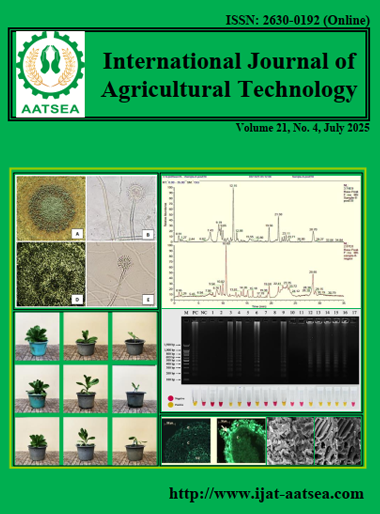Biosurfactant from Streptomyces zaomyceticus HUS20 isolated from the Indian Himalayan Region (IHR)
Main Article Content
Abstract
Actinobacteria, which are known to synthesize bioactive molecules with significant industrial and medicinal applications. In order to assess the possibility for producing biosurfactant (BS), this study sought to identify culturable actinobacteria from the high-altitude soils of Dugtu Village in the Indian Himalayan Region (IHR). Actinobacteria were isolated from pre-treated soil samples using nutrient agar, starch casein nitrate agar, and actinomycetes isolation agar, which were enhanced with 1% crude oil. Using the haemolytic assay, oil displacement test, emulsification activity, drop collapse assay, and penetration assay, morphologically different colonies were tested for the production of BS. Out of 58 actinobacterial cultures, strain HUS20 showed considerable emulsification index (65%) and a 30 mm zone in the oil displacement test. Using 16S rRNA sequencing, the strain HUS20 was shown to be 100% identical to Streptomyces zaomyceticus (GenBank accession: OQ996835.1). in HR LC MS analysis, the crude biosurfactant extract showed the presence of more than 164 metabolites. Additionally, the crude biosurfactant demonstrated strong antibacterial action against foodborne pathogens, with Bacillus cereus showing the greatest suppression (24 mm zone at 100 mg/ml). The potential of actinobacteria from harsh Himalayan habitats as a useful resource for the synthesis of biosurfactants is highlighted by this work. Streptomyces zaomyceticus HUS20 is a promising strain for isolation of potential biosurfactant molecule.
Article Details

This work is licensed under a Creative Commons Attribution-NonCommercial-NoDerivatives 4.0 International License.
References
Balouiri, M., Sadiki, M. and Ibnsouda, S. K. (2016). Methods for in vitro evaluating antimicrobial activity: A review. Journal of pharmaceutical analysis, 6:71-79. DOI: https://doi.org/10.1016/j.jpha.2015.11.005
Choi, S. H., Jang, Y. S., Jang, J. H., Bae, T. S., Lee, S. J. and Lee, M. H. (2019). Enhanced antibacterial activity of titanium by surface modification with polydopamine and silver for dental implant application. Journal of applied biomaterials & functional materials, 17:2280800019847067. DOI: https://doi.org/10.1177/2280800019847067
Felsenstein, J. (1985). Phylogenies and the comparative method. The American Naturalist, 125:1-15. DOI: https://doi.org/10.1086/284325
Jadhav, R. and Baghela, A. (2021). Yeast Research in India: A Perspective on Taxonomy and Applications. Progress in Mycology: An Indian Perspective, 591-626. DOI: https://doi.org/10.1007/978-981-16-2350-9_20
Kaur, P. and Vyas, M. (2023). Microbial surfactants: Environmental contamination management techniques for sustainable ecosystem. In Relationship between microbes and the environment for sustainable ecosystem services (pp.221-232). Elsevier. DOI: https://doi.org/10.1016/B978-0-323-89936-9.00001-1
Kaur, A., Kaur, M. and Vyas, P. (2023). Precise tuning of SiO2 thickness in SiO2@ Sr0. 4Ti0. 4Mg0. 2Fe2O4. 4 core–shell nanocomposites for augmenting photocatalytic and antibacterial activity. ACS Sustainable Chemistry & Engineering, 11:15577-15590. DOI: https://doi.org/10.1021/acssuschemeng.3c03747
Kumari, N. and Menghani, E. (2021). Evaluation of antibacterial activity and identification of bioactive metabolites by GCMS technique from Rhizospheric Actinomycetes. Indian Journal of Natural Products and Resources, 11:287-294.
Kumar, V., Muratani, M., Rayan, N. A., Kraus, P., Lufkin, T., Ng, H. H. and Prabhakar, S. (2013). Uniform, optimal signal processing of mapped deep-sequencing data. Nature biotechnology, 31:615-622. DOI: https://doi.org/10.1038/nbt.2596
Kumar, A., Singh, S. K., Kant, C., Verma, H., Kumar, D., Singh, P. P. and Kumar, M. (2021). Microbial biosurfactant: a new frontier for sustainable agriculture and pharmaceutical industries. Antioxidants, 10:1472. DOI: https://doi.org/10.3390/antiox10091472
Kumar, G., Kumar, R. and Sharma, A. (2015). Characterization of biosurfactants from indigenous soil bacteria recovered from oil contaminated sites. Journal of Environmental Biology, 36:1101.
Kumari, N. and Menghani, E. (2021). Evaluation of antibacterial activity and identification of bioactive metabolites by GCMS technique from Rhizospheric Actinomycetes. Indian Journal of Natural Products and Resources (IJNPR) [Formerly Natural Product Radiance (NPR)], 11:287-294.
Mishra, A. K., Mohanty, R. B., Ghosh, R., Mishra, K., Shukla, U. K. and Kar, R. (2022). Modern pollen–vegetation relationships along an altitudinal transect in the Western Higher Himalaya, India: Palaeoclimatic and anthropogenic implications. The Holocene, 32:835-852. DOI: https://doi.org/10.1177/09596836221096006
Ravindran, A., Sajayan, A., Priyadharshini, G. B., Selvin, J. and Kiran, G. S. (2020). Revealing the efficacy of thermostable biosurfactant in heavy metal bioremediation and surface treatment in vegetables. Frontiers in microbiology, 11:222. DOI: https://doi.org/10.3389/fmicb.2020.00222
Rodrigues, A. I., Gudiña, E. J., Teixeira, J. A. and Rodrigues, L. R. (2021). Biosurfactants as biocontrol agents against mycotoxigenic fungi. Biosurfactants for a sustainable future: production and applications in the environment and biomedicine, 465-490. DOI: https://doi.org/10.1002/9781119671022.ch21
Saitou, N. and Nei, M. (1987). The neighbor-joining method: a new method for reconstructing phylogenetic trees. Molecular biology and evolution, 4:406-425.
Satpute, S. K., Bhawsar, B. D., Dhakephalkar, P. K. and Chopade, B. A. (2008). Assessment of different screening methods for selecting biosurfactant producing marine bacteria. Indian Journal of Geo-Marine Sciences, 37:243-250.
Shirling, E. T. and Gottlieb, D. (1966). Methods for characterization of Streptomyces species. International Journal of Systematic and Evolutionary Microbiology, 16:313-340. DOI: https://doi.org/10.1099/00207713-16-3-313
Sharma, V., Singh, D., Manzoor, M., Banpurkar, A. G., Satpute, S. K. and Sharma, D. (2022). Characterization and cytotoxicity assessment of biosurfactant derived from Lactobacillus pentosus NCIM 2912. Brazilian Journal of Microbiology, 53:327-340. DOI: https://doi.org/10.1007/s42770-021-00654-5
Sharma, S., Tiwari, P. and Pandey, L. (2021). Optimization of culture conditions for the production of biosurfactants. In Microbial Enhanced Oil Recovery: Principles and Potential. Singapore: Springer Singapore, pp.149-178. DOI: https://doi.org/10.1007/978-981-16-5465-7_7
Singh, R., Glick, B. R. and Rathore, D. (2018). Biosurfactants as a biological tool to increase micronutrient availability in soil: A review. Pedosphere, 28:170-189. DOI: https://doi.org/10.1016/S1002-0160(18)60018-9
Smith, C. A., O'Maille, G., Want, E. J., Qin, C., Trauger, S. A., Brandon, T. R. and Siuzdak, G. (2005). METLIN: a metabolite mass spectral database. Therapeutic drug monitoring, 27:747-751. DOI: https://doi.org/10.1097/01.ftd.0000179845.53213.39
Tanaka, H., Sugita-Konishi, Y., Takino, M., Tanaka, T., Toriba, A. and Hayakawa, K. (2010). A survey of the occurrence of Fusarium mycotoxins in biscuits in Japan by using LC/MS. Journal of Health Science, 56:188-194. DOI: https://doi.org/10.1248/jhs.56.188
Zhang, G., Huang, G., Xiao, L. and Mitchell, A. E. (2011). Determination of advanced glycation end products by LC-MS/MS in raw and roasted almonds (Prunus dulcis). Journal of agricultural and food chemistry, 59:12037-12046. DOI: https://doi.org/10.1021/jf202515k


